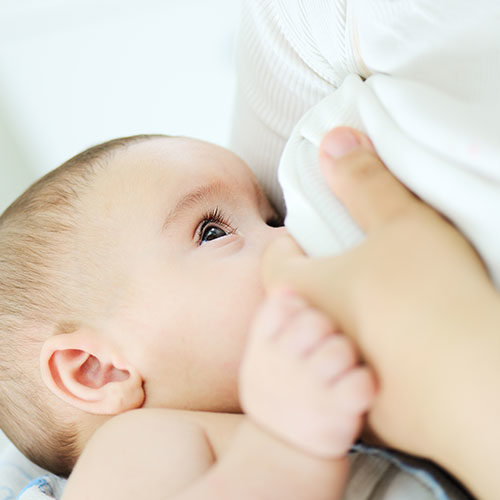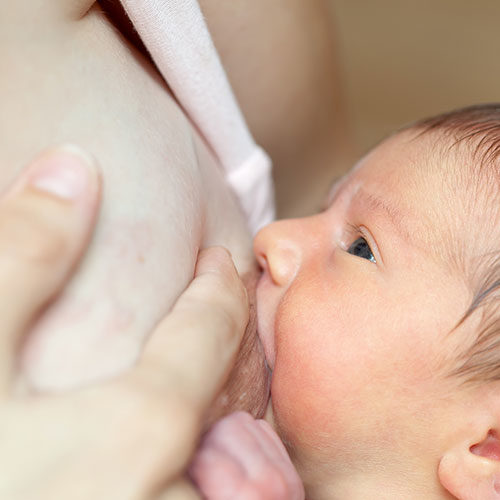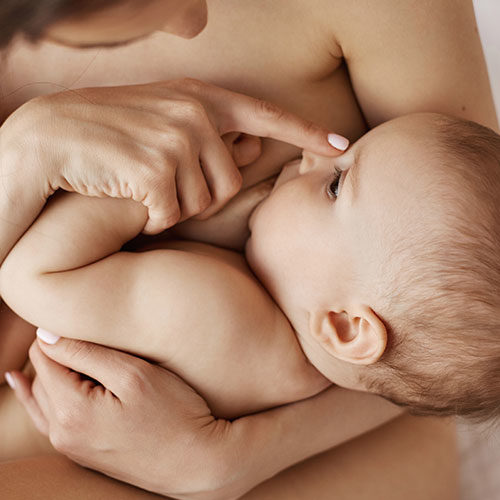What are the various breastfeeding positioning?
The first step at the beginning of every nursing session is positioning.
Positioning essentially describes the body postures of the baby and the mother when breastfeeding. Positioning is very important as it helps the baby get a good latch. Typically, if the baby is unable to latch properly, both the position and the latch may need to be readjusted. Sometimes, the breast also needs to be positioned in order to facilitate nursing. It is important to note that it is not always necessary. And, the need to do it goes on decreasing as the baby grows older.
What is of the highest priority is that the mother and baby are comfortable in whichever position they choose to breastfeed in.
The mother should not lean or bend towards the baby and the baby should not be twisted, i.e. the neck, the stomach and the whole body should be aligned.
The baby should be brought to the breast rather than the breast being brought to the baby.
Sit in a comfortable seat with a proper backrest – Could be a bed, sofa or chair.
Use any pillows to support the weight of your baby if need be.
Place the baby in a way in which the baby has a place to move its neck.
Make sure your baby’s head and body are at the breast level.
Offer breast support with the c-hold (which is the thumb on top and fingers and underneath the breast) or a U (thumb and fingers are at 3 o’clock and 6 o’clock).
Mother’s position:
It is very important that the mother remains comfortable while breastfeeding, whether she’s sitting up or lying down. Pillows can be used to support her back, arm and even the baby to sustain the baby at the breast level. It is essential to remember that the baby is supposed to be brought to the breast and not the other way around. So, a posture where the mother is leaning uncomfortably towards the baby or lying in a way where she’s experiencing some amount of discomfort should be avoided.
Leaning over the baby can cause backaches and/or neck/shoulder strain. And it can also make the latch less deep and cause more discomfort to either the baby or the mother. This may not be true in all cases, but it’s certainly a concern for babies who are struggling with deep latch due to various reasons.
In the early days, when both mother and baby are still adapting and getting used to breastfeeding, it helps for the mother to first be absolutely comfortable in her preferred nursing position, and then bring the baby to the breast.
Baby’s position: Just like the mother, the baby should also be comfortable while breastfeeding. The baby should be entirely turned towards the mother. A baby lying straight on the back with the only face turned towards the mother is not comfortable. The baby’s chin should be touching the breast, whereas the baby’s head should bend slightly backwards in order to facilitate swallowing. The baby’s ears, shoulders, back, and hips should all be aligned in a way that the baby’s body is not twisted. In the newborn days, it’s always preferred that the baby and mother have good skin to skin contact (stomach facing stomach). The baby’s neck, back and buttocks should be well-supported. Leaning the head backwards opens up the baby’s jaws. Furthermore, it facilitates active sucking, which is stimulated when the nipple is oriented upwards to the baby’s palate. It also prevents milk from spraying straight in the baby’s throat, which can cause gagging and choking.
Breast position: Breasts come in different sizes and shapes. Every baby can potentially learn to adjust to the given conditions including the breast and nipple size and shape and nurse efficiently. Sometimes the breast needs to be positioned in a certain manner so that the baby can find it easier to latch. For very large breasts, a rolled-up baby blanket to support the breast works well. For large nipples, just gently squeeze above the areola and help the baby latch (how we take a mouthful of a large burger by squeezing it gently). Think of holding the breast like a burger, moulding it with fingers parallel to the baby’s lips, but make sure that the fingers are placed at least two inches away from the areola so that the baby can get a good mouth full of the breast. It is important to understand that breast positioning is not always necessary. Also, as babies achieve greater head control as they grow bigger, they become very efficient at latching and need lesser assistance.
The above-described positioning of the mother and baby enables a good latch and comfortable nursing sessions. It’s very important because in the times of cluster feeding, nursing sessions may go on for hours together and a comfortable position prevents exhaustion and ensures willingness from both the parties to nurse as much as needed. This positioning should be followed consistently through different nursing positions viz. cradle, cross-cradle, football hold, side-lying etc.
Nursing Positions
There are various nursing positions. Mother can choose any of them as per her and her baby’s comfort. These positions work as guidelines in the initial days when mother and baby both are getting accustomed to breastfeeding. It’s important to remember, though, that, mother and baby are like pieces of a puzzle which fit each other perfectly. But each set of mothers and babies is unique. Thus, what works for one, may not work for another. So, it’s important to focus on mother-baby-duo specific needs, comfort level etc.
Since babies nurse very often, it is helpful when mothers think of creating a nest or a sanctuary, at least in the early days. Having a number of pillows handy, a book or a device, a TV, water and some wholesome snacks can help the mother-baby dyad settle in comfortably for those long hours. Breastfeeding is a learned skill for both the mother and baby. Experimenting with different positions can help you find your sweet spots. As the baby grows older, the entire setup is usually not required.

Image 1: Different Breastfeeding Positions:
Source: http://cae2392.blogspot.com/2012/07/breastfeeding-positions.html
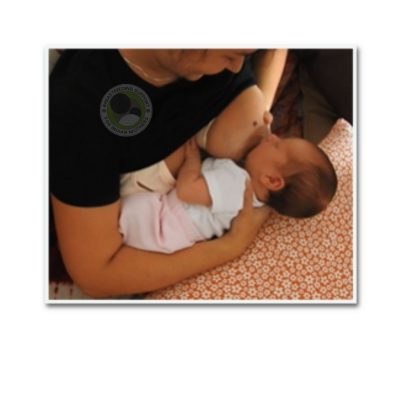
Image 2: Cross-Cradle Hold
1. Cross-cradle position: BSIM highly recommends that mothers start breastfeeding in this position. This position is called a modified cradle position, this position gives the mother more control and is very commonly used in the initial days of breastfeeding to figure out the working latch. The baby should be kept at the height of the breast. To nurse the baby in this position, the mother sits with her back well-supported. The baby is kept on a pillow or pillows, depending on the mother’s preference, across the mother’s lap, turned entirely toward the mother and is brought to nipple level. When the baby nurses from the left breast, the left breast can be supported by the mother’s left hand in a ‘U’ hold; (the mother’s fingers should always be parallel to the baby’s lips) while the baby is supported by the mother’s right hand. It’s done by gently placing the right hand behind the baby’s ears and neck, with the thumb and index finger behind each ear. Essentially, the baby’s neck rests between the thumb, index finger and palm of the mother’s right hand, forming a “second neck” for the baby. Avoid touching the baby’s head as this can irritate the baby and the baby will push ahead towards the breast first, resulting in a shallow latch. The mother’s inner arm runs along and supports the baby’s back. If the baby is breastfeeding on the right breast, the mother holds her breast with her right hand and supports the baby with her left hand. It’s important that the mother supports both her elbows with pillows too, so her arms don’t hold the weight of the baby; or else; they will tire before the feeding is finished. It is also important to keep all fingers (except the thumb) together while supporting the baby’s neck. When fingers are spread, they get tired easily, as it’s too much weight for them to handle individually for the duration of an entire nursing session. In this position too, upon looking down, the mother can see the baby’s side.
Once the baby is a little older and is able to maintain the latch without the mother having to support the breast, mothers can change into a cradle hold once the baby is latched and is drinking well. To do this, release the hand holding the breast and bring its arm under the baby’s head, while slowly letting go of the hand supporting the baby’s neck.
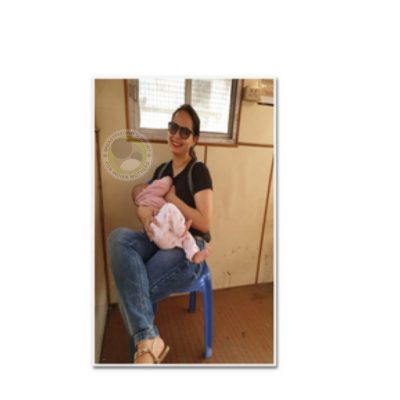
Image 3: Cradle Hold
2. Cradle position: In this position, the mother sits with her back well-supported. As the name suggests, the mother cradles the baby in her arms and brings her to the nipple level. When the positioning criteria are met (as described in the first section), the baby is latched. The mother supports the baby with the same hand as the side of the breast and holds the breast with the opposite hand. In this position, the baby’s head rests on the mother’s forearm, not at the elbow or wrist level, and the baby’s back will be along the mother’s inner arm and palm. The baby is turned entirely toward the mother. Upon looking down, the mother can see the baby’s side. This position works well once the baby is able to latch without any assistance.
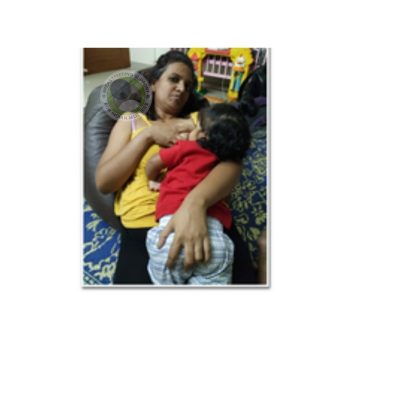
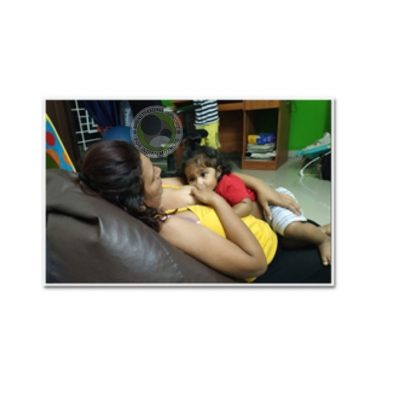
Image 4: Biological Nurturing on a Bean Bag
- Biological nursing position: Also called the ‘natural breastfeeding position’, this is the most natural position which encourages both mother and baby’s natural instinct to breastfeed (See image 4). The mother lies down on her back or lies comfortably in a reclining position. The baby is kept on the mother’s belly, facing her. It is best if there’s maximum skin to skin touch between mother and baby. In this position, the baby utilizes all five of her sensory organs to find and latch on to the mother’s breast. When a newborn is kept on her mother’s belly for the first time in this position, the baby uses her reflexes to move up to the mother’s breasts and latches. Like all other mammals, human babies are capable of finding their way to the mother’s breasts. They use their sight to locate the darker portion of the mother’s body (areola and nipple), their sense of smell to guide their way towards breasts (the mother’s areola smell like an amniotic fluid at birth), they gain warmth and security from the touch of mother’s body, and they derive comfort from hearing the familiar sound of their mother’s heartbeat. Babies are designed to move their hands and legs in upward to downward directions in order to facilitate movement towards the breasts. Once they find the breast, babies latch instinctively and taste the first food that nature intended for them. This entire process is called breast crawl. This position is helpful even later, as it’s very comfortable. It may help when the mother is struggling with latching. It’s also called a laid back position. Furthermore, it is very helpful when the mother has an overactive (fast) letdown of milk, as in this position, the baby is able to control the flow better as milk flows against gravity and thus, the overactive letdown is neutralized while breastfeeding. A modified version of this position can be used for mothers having delivered through a C-section. However, the mother may not be able to support the baby and may need assistance from a partner and/or others in this variation.

Image 5: Football position
- Football position:This position is also called a ‘clutch hold’. The baby is sitting up and latched on to the mother from the side. The mother sits with her back well-supported and holds the baby like a football under her. So, the baby’s head is in the mother’s hand (palm) and her back is along the mother’s arm beside her. The baby’s legs and feet are tucked under the mother’s arm or on a pillow, placed on the side. Here too, the mother creates the second neck for the baby like in the cross-cradle position, the baby is held with the right hand while she nurses from the right breast and the breast are supported with a ‘C’ hold with the left hand. The hands supporting the baby and breast are reversed when the baby is nursing from the left breast. Pillows are used to bring the baby to the right height. This position is very useful when the mother has undergone a C-section (so that there is no pressure on the incision). This position also works wonders when the baby refuses a particular breast. Football holds works great for twins/ babies of different ages (tandem nursing) when both babies want to nurse together.
4a. Modified football hold
The baby is still on the mother’s side, but on a pillow, with legs curled around the body like in the cradle and cross-cradle hold.
The breast is held by the opposite hand; the baby is held similarly to the cross-cradle hold, but by the hand and arm which are on the same side as the breast.
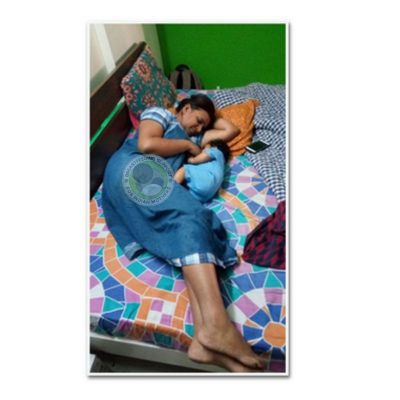
Image 6: Nursing Side-Lying
- Side-lying position:This position is potentially the most comfortable position for most mothers. It provides much-needed rest to the mother in times of cluster feeding, growth spurts and sleep regressions. In this position, both mother and baby lie on their sides facing each other. Pillows can be used to support the mother’s back, between her knees and below the baby to bring a baby to the nipple level. A pillow or rolled blanket behind the baby’s back will keep the baby from rolling away. The baby can be cradled in the mother’s arm with her back along the mother’s forearm. The side-lying position is safe and can be used from day 1 itself. A popular belief is that breastfeeding in the lying down position can cause ear infections. This is not true.
Even when the mother is sitting up to feed, the baby is in the same position as when side-lying and nursing. The myth about ear infection has come into existence due to the mistaken transfer of bottle feeding-related information on to breastfeeding.
When a baby drinks Artificial Baby Milk/ Expressed Breast Milk (EBM) from a bottle while lying down flat, it can get into the Eustachian tubes and middle ear and cause an infection.
However, firstly, it’s important to remember here that Artificial Baby Milk and breast milk are not the same. Breast milk inhibits the formation of bacteria, while Artificial Baby Milk encourages bacterial growth. And secondly, breastfeeding and bottle feeding is not the same. Milk does not pool in the mouth when the baby is breastfeeding, as opposed to bottle-feeding when milk/formula does pool in the baby’s mouth. Similarly, another belief saying breastfeeding in the lying down position can cause the mother to roll over her baby or suffocate them is untrue as well. Thus, it’s a perfectly safe position as long as safe sleeping guidelines are followed – which involve – no smoking or alcohol consumption by parents, the bed should not be too soft, there should not be toys on the bed, baby should not be heavily dressed, baby’s face should not be covered, and baby should be put to sleep to her back.
A mother who nurses lying down is more likely to nurse long term because it is less exhausting.
Caution: The mother/ care provider should remove the pillow from underneath/near the baby (if she uses one) before sleeping off on her back. Read more about nursing lying down here.
If you are seeking one-on-one lactation support from the comfort of your home, Breastfeeding Support for Indian Mothers offers Online Lactation Consultation, which can be booked here.
We also provide volunteer support on our 24X7 support group on Facebook, which you can join by clicking here.
P.S.: We do not accept Facebook profiles with inaccessible information. If your profile is locked/ inaccessible, you will need to send a Personal Message to our Facebook Page to join our free Facebook support group.
Sources :
Easy Breastfeeding by Camilla Conti
Child care : 2nd edition, BPNI-Maharashtra state branch
www.llli.org
www.kellymom.com
www.breastcrawl.org
Note: Images used on this page are BSIM owned images
We understand and acknowledge that parents and babies can be of various genders on a spectrum of the LGBTIQA+. Families come in diverse flavors. However, in our articles, for the sake of simplicity and convenience, we will be referring to the breastfeeding parent as the mother and using the female pronouns- ‘she’ and ‘her’ for babies. Babies can be nourished and nurtured in different ways and while we have used the terms breastfeeding and nursing, we recognize that parents can opt to chest feed or finger feed.
Wish to speak with a member of our team who is a certified lactation professional and also an experienced breastfeeding mother, click on this link.
Medical Advice Disclaimer
THIS WEBSITE DOES NOT PROVIDE MEDICAL ADVICE.
The information, including but not limited to, text, graphics, images and other material contained on this website are for informational purposes only. No material on this site is intended to be a substitute for professional medical advice, diagnosis or treatment. Always seek the advice of your physician or other qualified health care provider with any questions you may have regarding a medical condition or treatment before undertaking a new health care regimen, and never disregard professional medical advice or delay in seeking it because of something you have read on this website.
Disclaimer
We understand and acknowledge that parents and babies can be of various genders on a spectrum of LGBTQI+. Families come in diverse flavours. However, in our articles, for the sake of simplicity and convenience, we will be referring to the breastfeeding parent as the mother and using the female pronouns- ‘she’ and ‘her’ for babies. Babies can be nourished and nurtured in different ways and while we have used the terms breastfeeding and nursing, we recognize that parents can opt to chest feed or finger feed.
We don’t have conflicts of interest and declare, and we are compliant with the WHO code of marketing of breastmilk substitutes and the IMS act.
In case you find any information on this website that needs to be updated, please write to us at info@bsim.org.in

